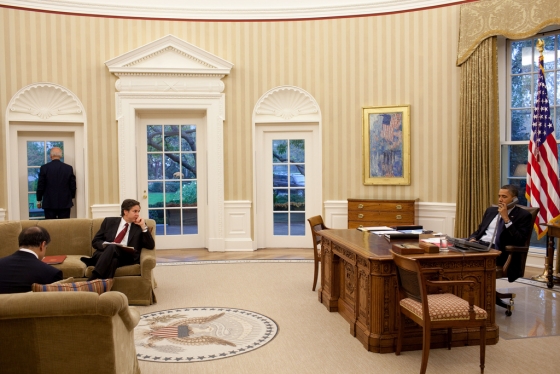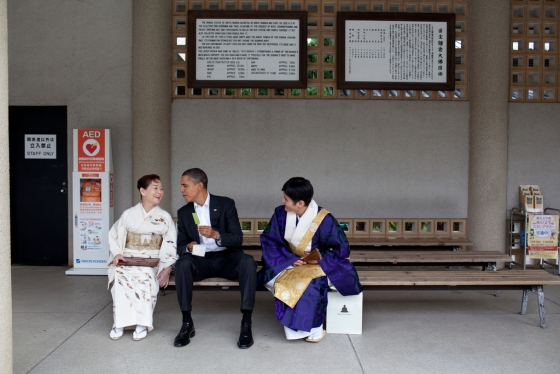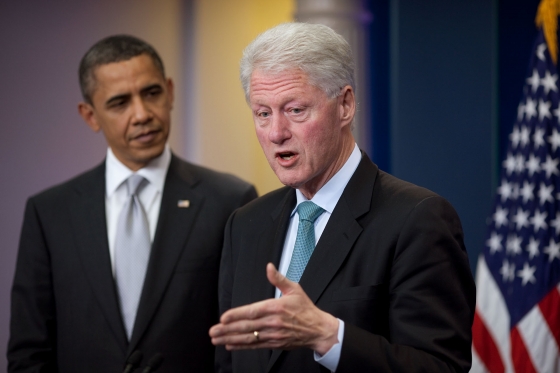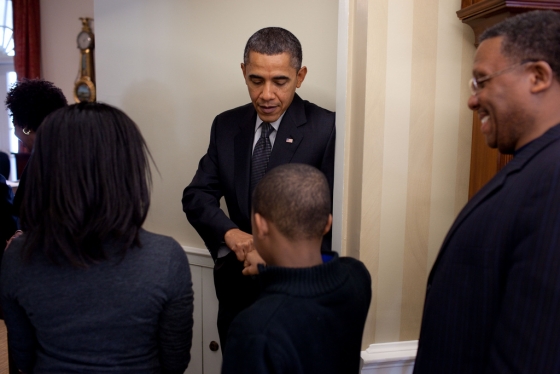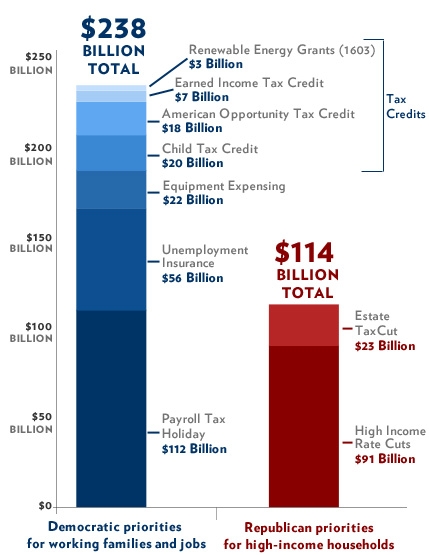-
Ed. Note: This is the second in a series of posts from top Administration Officials on the importance of the DREAM Act. Read Education Secretary Arne Duncan's post here.
Early in my career, I worked as a student advisor and higher education recruitment counselor. Many of the young people I worked with were undocumented, including a college-bound young man whose academic achievements and dedication to hard work made him a model student in everyone’s eyes. He gave everything his all, and today he’s an environmental scientist. He has a rewarding, interesting and good-paying job. And he is making his own unique contribution to our country and the world.
He understood what a privilege it is to live in a country that allowed him to get a good education. That’s precisely why he chose to give back through public service. It’s his way of showing his profound gratitude.
I think about him every time I talk about the DREAM Act–legislation designed to stop punishing innocent young people for the actions of their parents, by giving them the chance to either obtain legal status by pursuing a higher education, or by serving in the U.S. armed forces.
The DREAM Act has long enjoyed bipartisan support. And the vote in the House of Representatives this week followed suit, with eight Republicans voting to pass the measure.
There’s no reason why it shouldn’t receive that kind of support in the Senate. It’s time to act. Now.
-
We just uploaded to the White House Flickr photostream 79 new pictures from the busy month of November. I thought you might find it interesting if I explained my thought process on a couple of the photographs.
The President makes a lot of phone calls from the Oval Office, including this one to Jalal Talabani of Iraq. Because the Vice President and others were also in the office, I wanted to include them in my frame. The Vice President kept moving about the Oval Office throughout the phone call and thus I was constantly changing my angle to keep him in the background. There were many photographs to choose from, but this seemed to be the best one because of the framing: the Vice President looking out the window in the background and his national security advisor, Tony Blinken, looking towards the President as he spoke on the phone.
The majority of the photographs presented in the Flickr photostream are from behind-the-situations that only I have access to. This picture falls into the category where press photographers were present but I had a different angle than they did. Since I was much closer to the President than the press photographers, I was able to use a wider lens and incorporate more in the background. I framed it purposely to include the Japanese writings and signs, and caught a moment as the President–with his green tea ice-cream bar in hand–leaned into the woman who had just given him a tour of the Great Buddha.
You can see the rest of the photostream below.
-
The President strongly urges both parties in Congress to pass the compromise on tax cuts, unemployment insurance, and job creation. Not doing so would hurt the middle class, those struggling to find work, and the economy itself.
-
President Obama was joined by President Clinton in urging Congress to pass the compromise framework on tax cuts, unemployment insurance and job growth. Watch the full video below:
-
West Wing Week: “It’s alive!” Watch the video.
Notable Number: $2,500. Learn more about how the President saved more than 8 million students that much in tuition costs.
-
Ed. Note: This is the first in a series of posts from top Administration Officials on the importance of the DREAM Act.
Now is the time to press on with our full support for the DREAM Act. We’re closer than we’ve ever been and we’re not giving up.
The President, myself, and many of my Cabinet colleagues have held conference calls, talked to the press, and written op-eds and letters of support. We will keep doing whatever it takes to make this happen for thousands of hard-working, patriotic young people who are leaders in their communities and who are looking for an opportunity to attend college or serve our country in the military, but who can’t, through no fault of their own. The Senate has the chance to offer them and our nation a brighter future by coming together in a bipartisan way to pass the DREAM Act.
-
For too long, many government IT projects cost hundreds of millions of dollars more than they should, took years longer than necessary to deploy, and delivered technologies that were obsolete by the time they were completed.
This summer we took a hard look at 26 high priority projects that were either over budget, behind schedule, or at high risk for the kinds of problems that too often plague our large IT efforts. We completed the review of two projects in October, and this week, we announced the results from our review of the next 16 projects.
-
One project has been terminated entirely, as the agency decided the project was too troubled to continue.
-
For seven projects we have accelerated delivery of meaningful functionality.
-
For eight projects, we’ve rescoped the projects back to increase the likelihood of success and reduced budgets in the process.
The bottom line is that we’ve reduced lifecycle cost by $1.3 billion, and cut the time for delivery of functionality down by more than half, from two to three years down to an average of 8 months.
In reviewing 38 total projects, we have significantly accelerated delivery in 12 projects, with increased functionality coming online every few quarters rather than every few years, and reduced the scope or terminated 15 others, achieving a total of $3 billion in lifecycle budget reductions.
-
-
Today, we got some good news about how the Affordable Care Act is already making a difference in people’s lives across the country. The California Public Employees’ Retirement System (CalPERS), which provides retirement and health benefits to more than 1.6 million people and their families, sent me a letter detailing how the new law has already helped them improve benefits and keep down costs for thousands of retirees and their family members.
One of the new law’s key first-year provisions allows most children who don’t get health coverage from their jobs to stay on their parents’ plans until they turn 26. CalPERS reports that under this provision, 27,000 young adults will get coverage by the beginning of next year. That’s not only good news for those young people, but imagine what a relief it is to their parents and other family members who worried that their sons, daughters, brothers, and sisters were going to be uninsured. Instead, thousands of families will have new peace of mind next year.
According to the letter, another of the Affordable Care Act’s provisions CalPERS is making a big dent in the cost of insurance. The new law created the Early Retiree Reinsurance Program to help plan sponsors like CalPERS maintain health coverage for early retirees and their families, for whom premiums have skyrocketed in recent years. So far, approximately 4,700 employers and unions have signed up, including CalPERS.
In its letter, CalPERS explained that by factoring the new program into its 2011 health plans, it was able to provide approximately $200 million in premium savings to 115,000 early retirees and their families. That makes a huge difference at a time when many families are struggling to pay their bills and make ends meet.
This letter is good news for California families, and we’re seeing similar signs of progress across the country. Just nine months after it was signed into law, the Affordable Care Act is already fulfilling its promise to help working Americans get and keep insurance, and to slow rising costs for those who have coverage, while ending some of the worst practices of the insurance industry with a new Patient’s Bill of Rights. And in the months to come, we look forward to working with CalPERS and employers across the country to implement this new law and make sure all Americans can get the care they need.
Kathleen Sebelius is Secretary of Health and Human Services
-
The President is committed to promoting a strong, growing economy – one that’s creating jobs, fostering a thriving middle class, and extending opportunity to all American workers. That’s why he fought so hard to ensure that the priorities of working families were advanced in the agreement introduced today in the Senate.
As the chart above demonstrates, the bipartisan agreement we’ve forged delivers several key victories – victories that will give the average American family assurance that there will be more money to pay the bills each month:
-
Ed. Note: Watch the full National Christmas Tree Lighting ceremony and show with musical performances by B.B. King, Sara Bareilles, Common, Maroon 5 and more at www.thenationaltree.org.
Last night, the First Family continued a proud holiday tradition – lighting the National Christmas Tree for the 88th time. View photos from the event and watch a video of the President's remarks, the tree lighting ceremony, and a reading of "Twas the Night Before Christmas" by the First Lady.
-
In recent days, there has been some confusion about the ability for businesses and insurance plans to receive blanket waivers from following the new consumer-focused rules of the road in the Affordable Care Act – the health reform law. As we continue to move forward with implementation, and work with the business community, insurance industry, state leaders, consumers and everyone else with a stake in improving our health care system, it is important that we set the record straight.
Here are the facts:
Today, over 165 million Americans get their health insurance through an employer—comprising nearly 70 percent of America’s insured population. Employers offer health insurance as a way to attract the best and brightest candidates in the work force. Employer-based insurance is the most common and efficient source of insurance coverage, which is why the Affordable Care Act takes steps to strengthen the employer-sponsored insurance market and make it easier and affordable for businesses to offer coverage to their workers.
However, not all coverage offered by employers is the same. Employers who hire full time middle to high income workers tend to offer more comprehensive plans that cover essential health benefits (hospital care, physician visits, preventive services, among others) and provide sufficient security against financial risk of illness and accidents for their employees. These employers offer more comprehensive coverage because workers are more likely to be able to pay their share of the premium. Workers at these firms are also more likely to work at the company for an extended period of time, making it good business sense for employers to invest in their workers’ long-term health since good health is linked to increased productivity. The law ensures this system continues, while helping to lower health care costs and providing financial support for employers who offer coverage to their retirees too young for Medicare through the Early Retiree Reinsurance Program.
Unfortunately, many workers don’t have this kind of quality coverage. Employers who hire lower wage, part time or seasonal workers are more likely to offer limited benefit plans. Retail or chain restaurant employers frequently offer limited benefit plans that contain less comprehensive coverage and annual dollar limits on how much workers can receive in health coverage. The premiums for these limited benefit policies (known as mini-meds) are significantly lower than for policies with comprehensive coverage and are more affordable for lower wage workers and their families. In exchange for the low premiums, these policies generally come with high deductibles and annual dollar caps as low as $2,000. In addition, in many cases, employees are paying the full cost of the insurance policy, with no help from their employer.
-
This week, President Obama laid out an agreement on tax cuts and Unemployment Insurance that directly benefits women, mothers and working families. The agreement not only secures vital tax relief and investments in America’s workers that will create jobs and accelerate economic growth, it also contains specific policies that provide targeted support for working families, particularly women and mothers.
The agreement will extend key provisions including the Earned Income Tax Credit (EITC) and the Child Tax Credit (CTC) that disproportionately benefit women and working families. The American Opportunity Tax Credit (AOTC) is an additional benefit which gives working families and students a $2,500 per year partially refundable tax credit to help students and their families cover the cost of college tuition. Together, these credits will get women and their families on the road to economic recovery.
A closer look at the framework shows that women represent about 60 percent of the parents who will benefit from the EITC and CTC expansions in the agreement. Families headed by single mothers are among the most economically at risk in our fragile recovery, and this extension of the EITC and CTC would direct substantial resources to these families. In fact, an estimated 4 million of the families who will gain from this agreement are headed by a single mother – that’s one out of every three families who will gain from the extension of these credits.
A tangible example of someone who would benefit from the framework agreement on tax cuts and Unemployment Insurance highlights the importance of moving forward. In Columbus, Ohio, a single mother working as a cashier with two children aged 5 and 8 has an income of $16,900, the median salary in her profession in Ohio. The middle class tax cuts renewed under the framework provide this family with a tax cut of $620. In addition, due to priorities the Administration insisted on in the package, the framework provides the family with about $1,720 in further tax relief:
- Expanded Child Tax Credit: Under the agreement, she would receive $2,000 in child tax credits, compared to about $620 if only the 2001/2003 tax cuts were extended – an increase of about $1,380.
- A new 2% payroll tax cut: Due to the about 2% payroll tax cut for employees included in the agreement, this family would receive about $340 in tax relief.
As you can see, this isn’t just a theoretical debate. This tax plan will have a direct impact on the lives of Americans across this country every day. President Obama has stood with the middle class his entire career and this bill is just one more example of his commitment.
For more information on framework tax agreement, please read How the Tax Deal Benefits Women and Families.
Valerie Jarrett is Senior Advisor to the President and Chair of the White House Council on Women and Girls
-
Ed. Note: This live event has concluded. Check back for the full video.
The White House Fellows Program is one of America's most prestigious fellowships for leadership and public service. In Tuesday Talks, we're answering your questions about the program designed to provide exceptional men and women with a first-hand experience working at the highest levels of the Federal Government. The President’s Commission on White House Fellowships is currently accepting applications for the 2011-2012 Class. The application deadline is January 14, 2011.
Program Director Cindy Moelis and former Fellows Jaime Areizaga-Soto (Class of 2007-2008), Senior Attorney Advisor for the U.S. Agency for International Development and Esther Benjamin (Class of 1999-2000), Director of Global Operations for the United States Peace Corps will be answering your questions about the application and the Fellowship experience in a live video chat.
Join us for a talk on Tuesday, December 14th at 1:00 p.m. EST:
Here’s how you can participate in advance:
Join live on Tuesday, December 14th at 1:00 p.m. EST:
- Join the discussion live through the White House Facebook application
- Watch the chat through WhiteHouse.gov/live
Visit WhiteHouse.gov/fellows to learn more about the program.
-
Welcome to the West Wing Week, your guide to everything that's happening at 1600 Pennsylvania Ave. Walk step by step with the President as he visits Afghanistan to celebrate the holidays with our men and women in uniform, announces a free trade agreement with South Korea, attends a series of meetings at the White House and holds a press conference to answer questions about the tax cut compromise, signs the Claims Resolution Act of 2010, and more…
December 3rd, 2010
December 6th, 2010
December 7th, 2010
December 8th, 2010
-
The menorah used at the White House Hanukkah ceremony was generously loaned from the Congregation Beth Israel in New Orleans -- one of very few items from the congregation that survived the devastation of Katrina. “Five years ago, when Hurricane Katrina hit, the synagogue was covered in eight feet of water. Later, as the cleanup crew dug through the rubble, they discovered this menorah, caked in dirt and mold,” said President Obama in his remarks, “And today it stands as a reminder of the tragedy and a source of inspiration for the future.”
Just before the candle lighting, Rabbi Uri Topolosky of Congregation Beth Israel in New Orleans shared the story of the menorah with us:
Today, Congregation Beth Israel has just broken ground on a new synagogue and they look forward to lighting this menorah as part of the dedication ceremonies next year at Hanukkah.
-
This morning the President met with his Export Council to continue work on his goal of doubling our exports for goods and services over five years and creating millions of jobs in the process. But as he continues to pursure this medium-term goal, he took a moment in his opening remarks to make clear there is a much more urgent and time-senstive matter at hand:
Now, everyone in this room is committed to promoting a strong and growing economy -- one that’s creating jobs, fostering a thriving middle class, and extending opportunity for all who are willing to work for it.
And as we meet here, there is an important debate I think most of you are aware of on Capitol Hill that will determine, in part, whether our economy moves forward or backward. The bipartisan framework that we’ve forged on taxes will not only protect working Americans from seeing a major tax increase on January 1st; it will provide businesses incentives to invest, grow and hire. And every economist that I’ve talked to or that I’ve read over the last couple of days acknowledges that this agreement would boost economic growth in the coming years and has the potential to create millions of jobs. The average American family will start 2011 knowing that there will be more money to pay the bills each month, more money to pay for tuition, more money to raise their children.
But if this framework fails, the reverse is true. Americans would see it in smaller paychecks that would have the effect of fewer jobs.
So as we meet here today to talk about one important facet of our economic strategy for the future, I urge members of Congress to move forward on this essential priority.
A chart from the Center on Budget and Policy Priorities, via Ezra Klein, demonstrates just how much of this package goes to middle class and working families:
-
Over this past weekend, President Obama announced that the United States and Korea had come to terms on a trade agreement between our two countries. You may have heard that this deal had been in the works for a while; many were hoping for an announcement during the recent G20 in Seoul, but President Obama insisted that we keep working to improve the agreement on behalf of American workers. After a lot of long days and nights over the past few weeks, now we have an agreement for which American workers, farmers, ranchers, manufacturers, and service providers can all cheer.
The tariff cuts alone in the U.S. – Korea trade agreement will increase exports of American goods and services by $10 to $11 billion. We expect this agreement to create 70,000-plus jobs for American workers in a wide range of economic sectors from autos and manufacturing to agriculture.
-
In this edition of White House White Board, Austan Goolsbee, Chairman of the Council of Economic Advisers, discusses the President’s compromise framework on tax cuts, unemployment insurance & job creation.
Viewing this video requires Adobe Flash Player 8 or higher. Download the free player. -
On his first full day in office, the President signed the Memorandum on Transparency and Open Government, which directed Executive departments and agencies to “offer Americans increased opportunities to participate in policymaking and to provide their Government with the benefits of their collective expertise and information.” President Obama is committed to tapping ideas from the American people to make government work smarter, better, and more efficiently. At its heart, open government is about changing the relationship between government and the American people.
One vexing challenge to engaging Americans in governance has been finding new models and tools for the next generation of citizen consultation. We want to take advantage of the latest technology to: 1) enable government officials to circulate notice of opportunities to participate in public consultations to members of the public with expertise on a topic; and 2) provide those citizen experts with a mechanism to provide useful, relevant, and manageable feedback to government officials.
-
On December 8th, 2009, the White House issued an unprecedented Open Government Directive requiring federal agencies to take steps to achieve key milestones in transparency, participation, and collaboration. On the one-year anniversary of the Directive, Chief Technology Officer Aneesh Chopra, Chief Information Officer Vivek Kundra and Administrator of the Office of Information and Regulatory Affairs Cass Sunstein answered your questions from Facebook and WhiteHouse.gov on the Administration’s progress and where we're going.
You can check out the full video of the chat or use the links below to jump directly to the questions you're interested in. Visit whitehouse.gov/open to learn more about the Open Government Initaitive.
- &lsaquo previous
- 1
- 2
- 3
- 4
- 5
- 6
- 7
- 8
- 9
- …
- next &rsaquo









